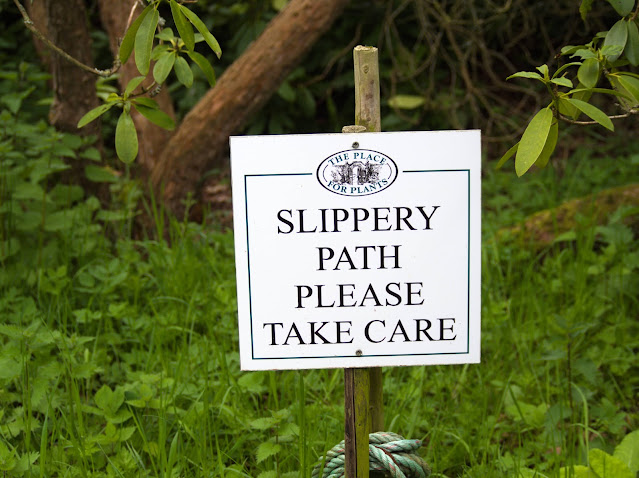I’ve been thinking there might be a book to be written, and one that I could possibly write, about walking in gardens. Of course I wouldn’t call it Walking in Gardens – that sounds like something Alan Titchmarsh would write – I’d be going for something like Shambling in Eden (yes, yes I know it needs work).
And of course it wouldn’t be all about the joys of walking around, say, the Chelsea Physic or Kew, though here, for reference, are some people walking in Kew:
I’d be more concerned with, say, the Poison Garden in Alnwick, Ian Hamilton Finlay’s Little Sparta, Charles Jencks’ The Garden of Cosmic Speculation, and so on.
 |
| Photo by Richard Tulloch (I think) |
And of course I’d also be concerned with imaginary or fictional gardens, the suicide garden in You Only Live Twice
and perhaps most obviously the one in Octave Mirbeau’s The Torture Garden (Le Jardin Des Supplices), a book that’s obviously driven jacket designers mad over the years.
There’s also a somewhat faithful film, Le Jardin Des Supplices 1976 directed by Christian Gion:
and there’s the 1967 film Torture Garden starring Jack Palance and Burgess Meredith that has almost nothing to do with the novel, but hey, it stars Jack Palance and Burgess Meredith.
And so, as research, I’ve been rereading the novel. The edition I own is the one above with Catherine Deneuve on the cover, and it also has a quotation on the back from my cineaste pal Anne Billson ‘This decadent classic flays civilised society down to its hypocritical bones and is le denier cri in kinky exoticism.’ Fair enough. She knows of what she speaks.
 |
| Self-portrait by Anne Billson from her blog Multiglom. |
There’s a key scene in the book where the narrator goes walking in the Torture Garden, which is at the centre of a prison, with Clara, the deracinated English ‘heroine’ who only feels at home and free in China, where the garden is located.
(Spoiler alert - everything grows so well in the garden because it’s fertilized with the corpses of tortured prisoners; actually not much of a spoiler, you would almost certainly have guessed)
Clara started walking again, very quickly … She walked on – a hard shadow on her eyes and her eyes aflame… Clara continued walking. I walked beside her and everywhere was a fresh surprise … Suddenly Clara stopped as though an invisible arm brutally descended on her.
‘Do you smell it?’
‘I smell the aroma of peonies.’
‘No that’s not it ... it smells as it does when I make love with you … Here it is here it is oh my darling.’
In fact a powerful phasphatic odour, an odour of semen wafted up from that plant (a ‘thalictus’ in the text, the RHS prefers the term thalictrum)
‘Why do so many flowers resemble sexual organs if not because nature ceaselessly cries out to living beings in all its forms and through its perfumes, ‘Make Love.’
I don't doubt that Gertrude Jekyll and Vita Sackville West felt much the same way.

































